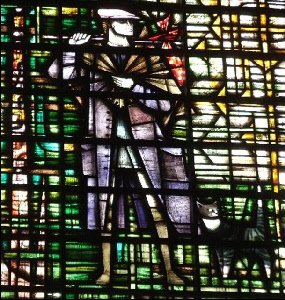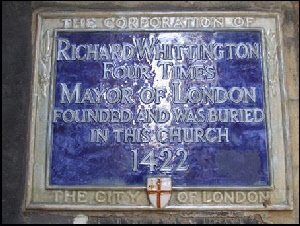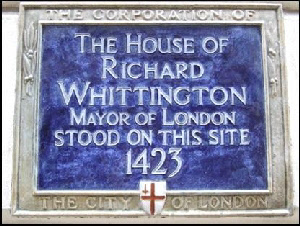There’s a wonderful story about Dick Whittington, isn’t there? The first dramatic presentation of this story was a play in 1606; a poor lad came to London to seek his fortune and was leaving town, deeply disappointed, when his cat talked him into having another go. He stayed, and became mayor three times.
Forget all that! Firstly, it wasn’t the cat that called him back, it was the bells of St Mary le Bow, secondly he was mayor four times and thirdly he was never poor.
The Museum of London (just down the road from us) tells us that Richard was the son of Sir William Whittington of Gloucester who died in the 1350s. The estate went to Richard’s elder brother, so Richard left Gloucester for London.
There he was apprenticed to a mercer and of course joined that guild. It is entirely likely that his father’s estate paid for his apprenticeship and his stake in business. He became a wealthy merchant dealing in velvet, silk and gold cloth from abroad. Since most of his trade was with the Royal Court, he came to the notice of King Richard II, and Henry IV, to whom he lent large sums of money.
This lovely picture, above, of the legend, cat and all, is in the window of St Michael Paternoster Royal on College St. To get there, follow Newgate St to Cheapside, right into Queen St, left into Canon St and College Hill is first right. This beautiful church, which hosts the Mission to Sailors, was first built by Whittington and was his own parish church. You can read the blue plaques on College Hill which shows where he lived.
The steps to becoming mayor, or Lord Mayor as it is these days, are as follows: first be a citizen of the City of London, then a guild member, then a freeman, then an alderman, then be elected Lord Mayor. Henry IV appointed him mayor on the death of Adam Bamme, but he was elected thereafter.
Whittington still lives! His will left a huge sum to be used for charitable works, one of which was an almshouse which is now in Stepney, run by the Whittington Charity. The Mercer’s Company is no longer a trade guild, but is still an important City institution and is given over entirely to managing the charities, including the Whittington Charity, that it administers.
In the 1400s the office of mayor was the government of the City of London, based in the Guildhall on what is now Gresham St. The Guildhall these days is the seat of the Corporation of the City of London, and the mayor is called the Lord Mayor but both institutions are direct descendents of the Medieval government.



